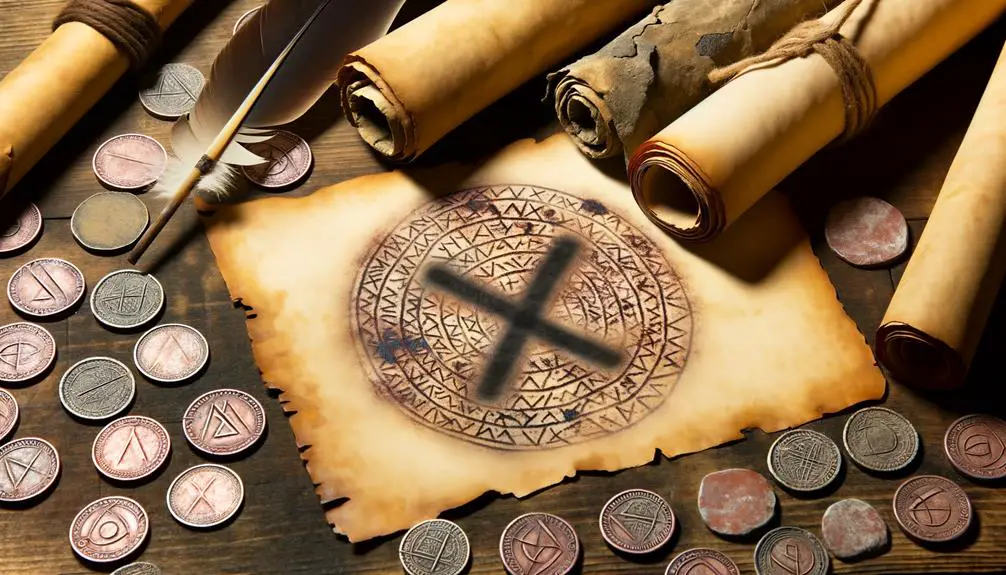What Does the Circle X Symbol Mean Across Cultures?
The circle with an X symbol, historically ingrained in Neolithic cave paintings and Mesopotamian tablets, signifies unity and completeness. Its religious and mystical connotations appear across Christianity, Buddhism, and Paganism, embodying spiritual balance and the cyclical nature of existence.
In contemporary culture, it is prevalent in art, fashion, and emblems, representing intersectionality and unity. Digitally, it indicates commands like closing windows or canceling actions, enhancing usability in interfaces.
Symbolically, it conveys themes of prohibition, rejection, or exclusion in media. This symbol's diverse applications reinforce its enduring relevance across multiple dimensions of human experience.
Explore further to understand its nuanced roles.

Key Takeaways
- The circle with an X symbol represents unity and the intersection of opposites.
- It frequently conveys themes of prohibition, exclusion, or restriction.
- The symbol is used in digital applications for actions like closing windows or canceling commands.
- Historically, it appears in ancient cave paintings, coinage, and pottery.
- In modern contexts, it symbolizes unity and intersectionality in art, fashion, and logos.
Historical Origins

The circle with an X symbol, often referred to as the 'X-in-a-circle,' has deep-rooted historical origins that can be traced back to ancient civilizations where it served various symbolic and practical purposes. Archaeological findings reveal its presence in Neolithic cave paintings, where it likely represented celestial bodies or cycles of time.
In Mesopotamian culture, this symbol was inscribed on clay tablets, possibly denoting protective talismans or boundary markers. Similarly, in ancient Greek and Roman contexts, it appeared on coinage and pottery, symbolizing unity and completeness. This emblem also functioned in navigational aids and cartographic charts, illustrating its versatile application across different domains.
The enduring presence of the X-in-a-circle underscores its multifaceted significance throughout history.
Religious Significance
The circle with an X symbol holds profound religious significance, tracing back to ancient spiritual symbols that represented unity and the intersection of opposites.
In modern contexts, this symbol has been reinterpreted, reflecting evolving theological and philosophical paradigms.
Analyzing these ancient and contemporary meanings provides a rich understanding of the symbol's enduring influence on spiritual thought.
Ancient Spiritual Symbols
Ancient spiritual symbols, like the circle with an X, often encapsulate profound religious significance and convey complex metaphysical concepts.
The circle is universally recognized as a symbol of unity, eternity, and the cyclical nature of life. When intersected by an X, it introduces a duality, representing the intersection of the material and spiritual worlds.
This amalgamation can be seen in various ancient cultures, from Celtic to Native American traditions, where it frequently signifies protection, balance, and the harmonization of opposites. Such symbols are not mere artistic expressions but serve as focal points for meditation, rituals, and the embodiment of esoteric wisdom.
Understanding these symbols requires an in-depth exploration into the cultural and religious contexts in which they were conceived.
Modern Interpretations
In contemporary religious contexts, the circle with an X continues to serve as a potent symbol, embodying themes of interconnectedness and spiritual balance that resonate across diverse belief systems. This emblem often signifies the unity of the physical and the metaphysical, bridging temporal existence with eternal truths. Its universal appeal is evident in various religious traditions, where it is used to illustrate the balance between opposing forces and the cyclical nature of life and death.
| Religion | Symbolism |
|---|---|
| Christianity | Intersection of divine and human spheres |
| Buddhism | Mandala representing cosmic order |
| Hinduism | Chakra symbolizing energy centers |
| Paganism | Circle of life and elements of nature |
| New Age | Harmony between body, mind, and spirit |
Mystical Interpretations

The circle with an X symbol has been imbued with mystical interpretations that trace their origins back to ancient civilizations, where it often represented notions of unity and the intersection of the material and spiritual domains.
In modern contexts, this symbol has been reinterpreted to signify concepts such as personal transformation and the convergence of dualities.
The enduring significance of these interpretations underscores the symbol's capacity to convey profound metaphysical insights across different epochs and cultures.
Ancient Symbolism Origins
Rooted in the esoteric traditions of various ancient civilizations, the circle with an X symbol often epitomizes a convergence of mystical beliefs and cosmic interpretations.
This symbol has been found across diverse cultural landscapes, each attributing unique esoteric meanings.
- Egyptian Cosmology: Represented the union of the sun (circle) and the four cardinal points (X), signifying the universe's completeness.
- Celtic Mysticism: Employed in druidic rituals, symbolizing the intersection of earthly and divine domains.
- Native American Spirituality: Known as the medicine wheel, it encapsulated the cyclical nature of life and the intersection of physical and spiritual journeys.
These interpretations underscore the symbol's profound role in articulating ancient civilizations' understanding of the universe, bridging the tangible and the ethereal.
Modern Interpretations Significance
Reflecting contemporary mystical thought, the circle with an X symbol continues to be a potent emblem, often interpreted as a representation of the unity between the material and spiritual spheres in modern esoteric practices.
This synthesis of domains is seen as central to achieving holistic understanding and enlightenment. The circle, an age-old symbol of infinity and wholeness, juxtaposed with the X, denoting intersection and convergence, encapsulates the dynamic interplay of opposites.
Mystics and spiritual practitioners assert that this symbol serves as a meditative focal point, aiding in the harmonization of inner and outer realities. Its geometric simplicity underscores a universal truth: the interconnectedness of all existence, resonating deeply with those seeking to bridge the tangible and the transcendental.
Modern-Day Usage
Intriguingly, the circle with an X symbol has found diverse applications in modern contexts, ranging from digital interfaces to cultural representations. Its presence is notable across various domains, reflecting its versatility and symbolic potency.
For instance, it appears prominently in:
- Contemporary Art: Artists employ the symbol in installations and paintings, often to evoke themes of negation or intersection.
- Fashion: The symbol is utilized in clothing designs and accessories, resonating with urban and alternative fashion aesthetics.
- Cultural Festivals: It is integrated into logos and emblems, symbolizing unity and intersectionality in multicultural celebrations.
These applications underscore the symbol's dynamic adaptability and its capacity to convey complex meanings, ensuring its relevance in diverse modern-day contexts.
Digital Applications

In the domain of digital applications, the circle with an X symbol appears in user interface design, gaming, and software development, often serving as an intuitive icon for actions such as closing windows, canceling commands, or representing critical game elements.
This symbol's widespread adoption is attributed to its universal recognizability and efficiency in conveying functionality. In user interfaces, its presence streamlines navigation, allowing users to terminate tasks swiftly. Within gaming, it frequently denotes pivotal actions, integrating seamlessly into gameplay mechanics to enhance user experience.
Software developers leverage this symbol to create consistent and intuitive interfaces, reducing cognitive load and enhancing usability. Consequently, the circle with an X symbolizes a fundamental element in digital interaction, optimizing both efficiency and user engagement.
Cultural Variations
Understanding the circle with an X symbol across different cultures reveals a fascinating array of interpretations and functionalities that extend beyond its digital applications. This emblematic motif has been imbued with diverse meanings, reflecting the variegated nuances of cultural semiotics.
- Spirituality and Religion: In some Eastern traditions, the circle with an X can symbolize the union of heaven and earth, an emblem of cosmic harmony.
- Historical Contexts: Various Indigenous cultures have used this symbol to represent critical geographical landmarks or sacred spaces.
- Social and Political Movements: In certain contexts, the symbol has been appropriated as a marker of resistance or solidarity, encapsulating collective identity and defiance against oppression.
These myriad interpretations underscore the symbol's multifaceted nature and its profound cultural resonance.
Symbolism in Media

The circle with an X symbol, steeped in diverse cultural meanings, also holds substantial significance within various forms of media, where it frequently conveys themes of exclusion, choice, or prohibition.
This symbol often marks elements that are forbidden or restricted, effectively communicating boundaries and limitations without the need for extensive textual explanation.
In video games, it denotes non-interactive objects or areas, guiding player behavior subtly yet effectively.
In film and television, it can symbolize rejection or disapproval, providing visual shorthand for complex emotional states.
The recurring use of this symbol in media underscores its utility in conveying clear, immediate messages, thereby enhancing narrative efficiency and audience comprehension.
Its simplicity belies a profound capacity for conveying nuanced and multifaceted ideas.
Conclusion
The circle with an X symbol, a nexus of historical origins, religious significance, mystical interpretations, and modern-day applications, serves as a versatile emblem across cultures and digital landscapes.
This omnipresent symbol, like a chameleon, adapts to diverse contexts—reflecting a spectrum of meanings from sacred to secular. Its enduring presence in media and cultural variations underscores its profound impact, echoing the timeless resonance of human symbolism throughout the ages.
Therefore, the symbol's multifaceted nature continues to captivate scholarly inquiry.






